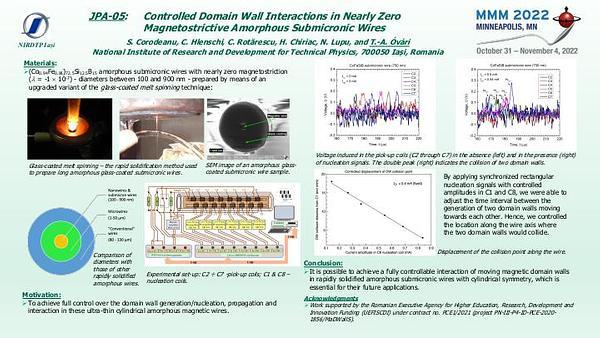Would you like to see your presentation here, made available to a global audience of researchers?
Add your own presentation or have us affordably record your next conference.
Amorphous ferromagnetic glass-coated microwires are known for their excellent magnetic properties, such as magnetic softness, ultrafast magnetization switching and the giant magnetoimpedance (GMI) effect. Said properties, as well as the hysteresis loop shape and domain structure of as-prepared microwires are strongly affected by the magnetostriction constant 1. However, these properties are prone to change after submitting the microwires to different annealing processes and/or external stimulus, and are dependent on the sample’s geometry 1,2. The combination and manipulation of these parameters are widely studied to adapt magnetic microwires to new technological applications.
Fe-rich microwires commonly exhibit bistable magnetic behaviour and poor GMI values. Past experiments on thin Fe microwires have shown an enhancement on their GMI effect after current annealing of samples, with hints to a change in their magnetic domain structure 3. However, while thin microwires are promising materials for development of microsensors, thicker ones are suitable for different applications, such as stress monitoring and tuneable composite materials. Thus, a study of Fe-rich, thick microwires is carried out.
A Fe71.8B13.27Si11.02Nb2.99Ni0.92 glass-coated microwire was produced, with metallic nucleus and total diameters d=47.9µm and D=63.2µm (ρ=d/D≈0.8). While short (12cm, same lenght as the pick-up coil used for measurement) samples show regular squared hysteresis loops, common for Fe microwires, asymmetric hysteresis loops are observed in 24cm long samples (Figure 1.a). Current annealing results in coercivity, Hc, increasing in both samples, being most noticeable for the long one (Figure 1.b).
On the other hand, GMI measurement yields an unexpected result, as, while its current annealing results in a proportionally smaller GMI ratio, ΔZ/Z, enhancement than that obtained on thin ones, the as-prepared microwire shows much higher ΔZ/Z -values and a double peak structure, usually denoting a different domain structure (Figure 2).
References:
1: V. Zhukova, M. Churyukanova, A. Talaat, et al. Effect of stress-induced anisotropy on high frequency magnetoimpedance effect of Fe and Co-rich glass-coated microwires. J. Alloys Compound, Vol. 735, p.1818-1825 (2018). https://doi.org/10.1016/j.jallcom.2017.11.235
2: V. Zhukova, J.J. del Val, L. Gonzalez-Legarreta, et al. Optimization of Soft Magnetic Properties in Nanocrystalline Fe-Rich Glass-Coated Microwires. JOM, Vol. 67, p.2108–2116 (2015). https://doi.org/10.1007/s11837-015-1546-x
3: A. Gonzalez, M. Ipatov, P. Corte-Leon, et al. Effect of Joule heating on GMI and magnetic properties of Fe-rich glass-coated microwires, AIP Advances, Vol. 12, p.035021 (2022). https://doi.org/10.1063/9.0000290

Fig.1: a) hysteresis loops of annealed samples and b) coercive field dependence on annealing times.

Fig.2: GMI ratios of as-prepared and annealed a) thin and b) thick microwires.
